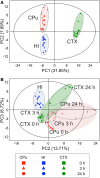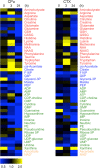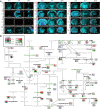Integrated MALDI-MS imaging and LC-MS techniques for visualizing spatiotemporal metabolomic dynamics in a rat stroke model
- PMID: 24772057
- PMCID: PMC3984668
- DOI: 10.1007/s11306-013-0588-8
Integrated MALDI-MS imaging and LC-MS techniques for visualizing spatiotemporal metabolomic dynamics in a rat stroke model
Abstract
Spatiotemporal information about biomolecules is indispensable for precise pathological analysis, but it remains largely unclear. Here we show a novel analytical platform combing mass spectrometry imaging (MSI) with its complementary technique, liquid chromatography-mass spectrometry (LC-MS), to elucidate more comprehensive metabolic behaviors, with spatiotemporal information, in tissues. Analysis of a rat transient middle cerebral artery occlusion (MCAO) brain tissue after ischemia-reperfusion was performed to characterize the detailed metabolomic response to pathological alterations. To compare the spatially resolved metabolic state between ischemic and contralateral hemispheres of the MCAO brain, coronally sliced tissues were subjected to MSI. We also measured the metabolites extracted from three different cerebral regions, including whole cortex (CTX), hippocampus (HI) and corpus striatum (CPu), by LC-MS. In the ischemic hemisphere, significant metabolic changes at the CTX and CPu were observed after reperfusion, while not at the HI. A region-specific metabolic behavior was observed in amino acid and nucleotide metabolism, as well as in the TCA cycle. Correlation between MSI and LC-MS data was relatively high in the CTX and CPu. Combination of both MS platforms visualized the diverse spatiotemporal metabolic dynamics during pathological progress. Thus, our proposed strategy will contribute to the understanding of the complex pathogenesis of ischemia-reperfusion.
Keywords: LC–MS; MSI; Metabolomic dynamics; Pathological analysis; Spatiotemporal behavior; Stroke.
Figures





References
-
- Bylund-Fellenius AC, Ojamaa KM, Flaim KE, Li JB, Wassner SJ, Jefferson LS. Protein synthesis versus energy state in contracting muscles of perfused rat hindlimb. American Journal of Physiology. 1984;246:E297–305. - PubMed
LinkOut - more resources
Full Text Sources
Other Literature Sources
